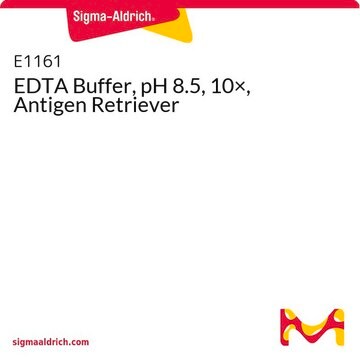EDS
Ethylenediaminetetraacetic acid
anhydrous, BioUltra, ≥99% (titration)
Synonyme(s) :
(Ethylenedinitrilo)tetraacetic acid, EDTA, Edathamil, Ethylenedinitrilotetraacetic acid
About This Item
Produits recommandés
Qualité
anhydrous
Niveau de qualité
Gamme de produits
BioUltra
Pureté
≥99% (titration)
Forme
powder
Pertinence de la réaction
reagent type: chelator
pH
2.5 (23 °C, 10 g/L)
Pf
250 °C (dec.) (lit.)
Solubilité
water: soluble 0.4 g/L at 20 °C
Chaîne SMILES
OC(=O)CN(CCN(CC(O)=O)CC(O)=O)CC(O)=O
InChI
1S/C10H16N2O8/c13-7(14)3-11(4-8(15)16)1-2-12(5-9(17)18)6-10(19)20/h1-6H2,(H,13,14)(H,15,16)(H,17,18)(H,19,20)
Clé InChI
KCXVZYZYPLLWCC-UHFFFAOYSA-N
Vous recherchez des produits similaires ? Visite Guide de comparaison des produits
Description générale
Application
- as a medium supplement in embryo culture using synthetic oviduct fluid culture 1 (SOFC1) medium
- in incubation of EpCAM+ cells with fluorescein isothiocyanate (FITC) conjugated antibody for cell sorting analysis
- in pre-treatment of single cell suspension of dendritic cells from spleen for cell sorting with magnetic beads
Mention d'avertissement
Warning
Mentions de danger
Conseils de prudence
Classification des risques
Eye Irrit. 2
Code de la classe de stockage
11 - Combustible Solids
Classe de danger pour l'eau (WGK)
WGK 2
Point d'éclair (°F)
Not applicable
Point d'éclair (°C)
Not applicable
Équipement de protection individuelle
dust mask type N95 (US), Eyeshields, Gloves
Faites votre choix parmi les versions les plus récentes :
Certificats d'analyse (COA)
Vous ne trouvez pas la bonne version ?
Si vous avez besoin d'une version particulière, vous pouvez rechercher un certificat spécifique par le numéro de lot.
Déjà en possession de ce produit ?
Retrouvez la documentation relative aux produits que vous avez récemment achetés dans la Bibliothèque de documents.
Les clients ont également consulté
Notre équipe de scientifiques dispose d'une expérience dans tous les secteurs de la recherche, notamment en sciences de la vie, science des matériaux, synthèse chimique, chromatographie, analyse et dans de nombreux autres domaines..
Contacter notre Service technique




